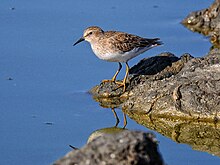Sandpipers
| Sandpipers | ||||||||
|---|---|---|---|---|---|---|---|---|

Gray-breasted sandpiper in splendid dress |
||||||||
| Systematics | ||||||||
|
||||||||
| Scientific name | ||||||||
| Calidris | ||||||||
| Merrem , 1804 |


The sandpipers ( Calidris ) are a genus within the family of snipe birds. They are small plover species that occur in the north of the northern hemisphere. A large number of the species breed in the subarctic.
In some places the vernacular describes the different species as “sea larks”.
To those in Central Europe regularly observed beach runners include red knot , sickle beach runner , dwarf beach runners , Sanderling , Alpine skiers beach and sea beach runner .
Appearance
The sandpipers have relatively long wings and legs and short tail feathers. The shape of the beak is variable to suit the respective diet. Some species have short and straight beaks, in other species the beaks are longer and often slightly curved at the end. This beak shape is particularly pronounced in the sickle sandpiper . The smallest species is the sandpiper , which only reaches a body length of 10 to 12 centimeters. It has a wingspan of 32 to 35 centimeters and weighs between 16 and 25 grams. The largest species is the great knot , which reaches a body length between 25 and 28 centimeters. Its wingspan is 60 to 67 centimeters. It weighs between 140 and 200 grams.
The plumage is typically light or brownish. In many species the head is dashed in dark brown, a dark eye stripe runs from the base of the beak to the eye and a lighter eye stripe runs above it. The feathers on the top of the body are broadly lined. The difference between a magnificent dress and a plain dress is not very pronounced. In the case of many species, only the red-brown tones are missing in the simple dress and the birds appear more gray-brown overall.
Distribution area
Sandpipers are tundra breeding birds and obligatory migratory birds. They use the short but nutritious summer in the far north for their reproduction. Some of the species have very long migration routes. For example, the red throated sandpiper migrates from its breeding grounds on the Bering Strait to New Zealand . Some species, such as the dunlin , spend three quarters of their lives on the migration route or in the wintering areas. They are often only in their actual breeding area for a few weeks and immediately move back to resting and moulting areas outside the breeding area after the young have become independent. On their long hikes, they sometimes end up in areas far away from the normal migration routes. For example, sandpipers are occasionally seen in Central Europe.
Way of life
Sandpipers live mainly on insects and their larvae, which they usually pick from the surface of the earth or water. Some species regularly poke for food in the damp subsoil and some also eat seeds.
The reproductive strategies of sandpipers are very different. Some enter into a monogamous seasonal marriage in which both parent birds are involved in the breeding and rearing of the young birds. In other species, the males are polygamous and only the female takes care of the offspring. The nest is usually just a shallow hollow, some species cover this hollow with plant material. The clutches are rarely larger than four eggs. The chicks flee the nest, but are usually fledged by one of the parent birds in the first days of life .
species
The following species belong to the sandpiper genus:
- Sanderling ( C. alba )
- Pointed tail sandpiper ( C. acuminata )
- Dunlin ( C. alpina )
- Baird sandpiper ( C. bairdii )
- Knutt ( C. canutus )
- Marsh Sandpiper ( C. falcinellus )
- Common sandpiper ( C. ferruginea )
- Common sandpiper ( C. fuscicollis )
- Sandpiper ( C. himantopus )
- Sandpiper ( C. maritima )
- Sandpiper ( C. mauri )
- Gray-breasted sandpiper ( C. melanotos )
- Pygmy sandpiper ( C. minuta )
- Common sandpiper ( C. minutilla )
- Bering beach rotor ( C. ptilocnemis )
- Ruff ( C. pugnax )
- Sandpiper ( C. pusilla )
- Spoonbill Sandpiper ( C. pygmaea )
- European sandpiper ( C. ruficollis )
- Long-toed sandpiper ( C. subminuta )
- Grass creeper ( C. subruficollis )
- Temminck sandpiper ( C. temminckii )
- Great Knutt ( C. tenuirostris )
- Sea runner ( C. virgata )
supporting documents
literature
- Richard Sale: A Complete Guide to Arctic Wildlife. Christopher Helm, London 2006, ISBN 0-7136-7039-8 .
Single receipts
- ↑ Tony Burnand: Wild - European game animals. Delphin Verlag, Stuttgart / Zurich 1967, p. 133.
- ↑ Sale, p. 185
- ↑ Sale, p. 184
- ↑ Arnd Stiefel and Horst Scheufler: Der Alpenstrandläufer , Die Neue Brehm-Bücherei, A. Ziemsen Verlag, Wittenberg Lutherstadt 1989, ISBN 3-7403-0160-0 , p. 107
- ↑ Sandpipers, snipes, coursers in the IOC World Bird List
